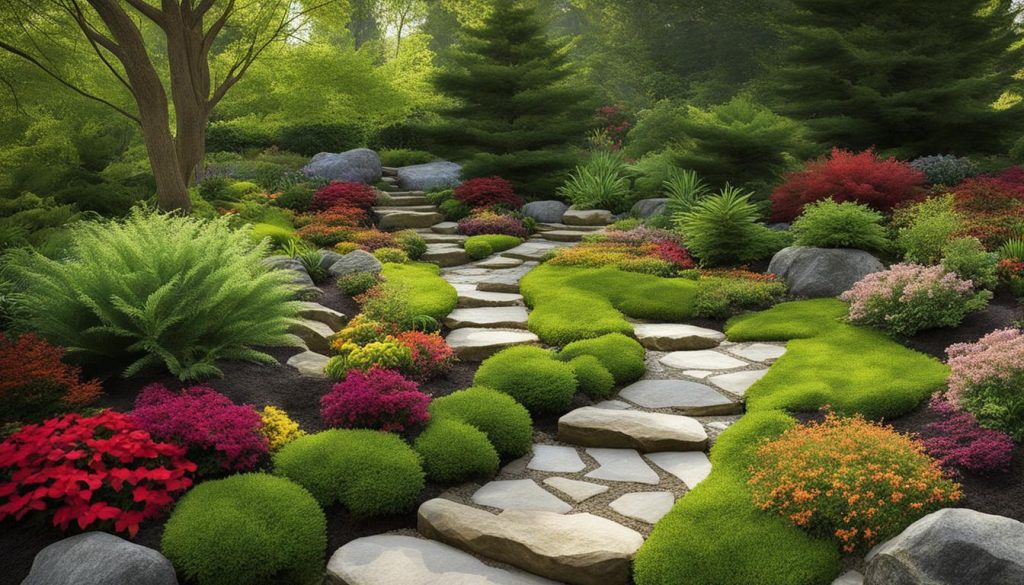If you’re looking to enhance the natural aesthetic of your outdoor space and incorporate Canada’s rocky charm into your landscape design, then you’ve come to the right place. In this article, we’ll explore the beauty of rock landscaping and provide creative ideas and inspiration to take your outdoor space to new heights.
Whether you’re starting a new landscaping project or looking to add some unique features to your existing space, rock landscaping offers an excellent opportunity to create eye-catching designs while staying true to nature. Rocks come in various colors, shapes, and sizes that can be incorporated into different landscaping elements, such as pathways, steps, and gardens, creating a natural and timeless appeal.
So, let’s dive into the world of rock landscaping to discover its benefits and how to use it to create an outdoor space that’s both beautiful and functional. Are you ready? Let’s get started!
Why Choose Rock Landscaping?
When it comes to landscaping, homeowners are always searching for low-maintenance, durable options that can withstand the test of time. Rock landscaping offers all of this and more. Here are some of the benefits of choosing rock landscaping for your outdoor space:
Low Maintenance
One of the greatest advantages of rock landscaping is its low maintenance requirements. Unlike traditional lawns that require regular mowing, watering, and fertilizing, rock landscaping is relatively easy to maintain. Rocks don’t require watering or mowing, and they are resistant to pests and other outdoor hazards. This means less time spent on upkeep and more time to enjoy your outdoor space.
Durability
Rocks are naturally durable and long-lasting, making them an ideal choice for landscaping projects. Unlike traditional landscaping materials such as wood or mulch, rocks won’t decompose or rot over time. They are resistant to weather conditions, including heavy rain and extreme heat, and won’t need to be replaced as frequently as other landscaping materials. This durability also makes them a cost-effective choice in the long run, as they require fewer replacements and repairs than other materials.
Overall, rock landscaping offers several benefits that make it a popular choice for homeowners. Its low maintenance requirements and durability make it a sensible option for those looking for a beautiful, long-lasting outdoor space.
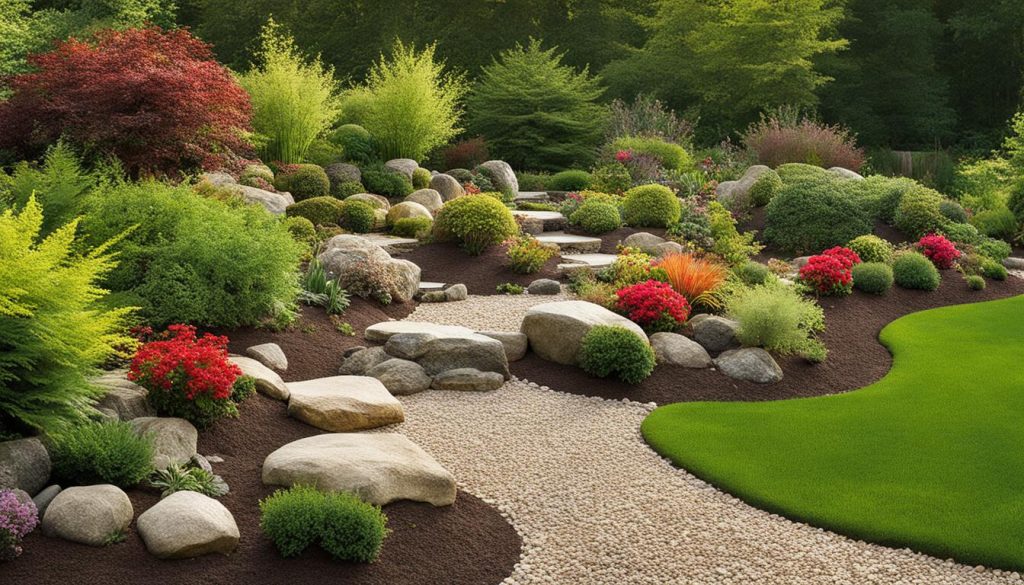
Using Rocks as Focal Points
Incorporating rock features into your landscaping design can create eye-catching elements that draw attention and enhance the overall visual appeal of your outdoor space. By strategically placing rocks, you can create focal points that elevate the natural aesthetic of your surroundings. In this section, we will discuss different ways to use rocks as focal points in your landscaping project.
Rock Formations
Rock formations are a great way to add dimension and texture to your landscaping design. You can use them as a backdrop for plants or as a standalone feature. For example, you could use a large boulder as a centerpiece and surround it with smaller rocks or plants to create a striking display.
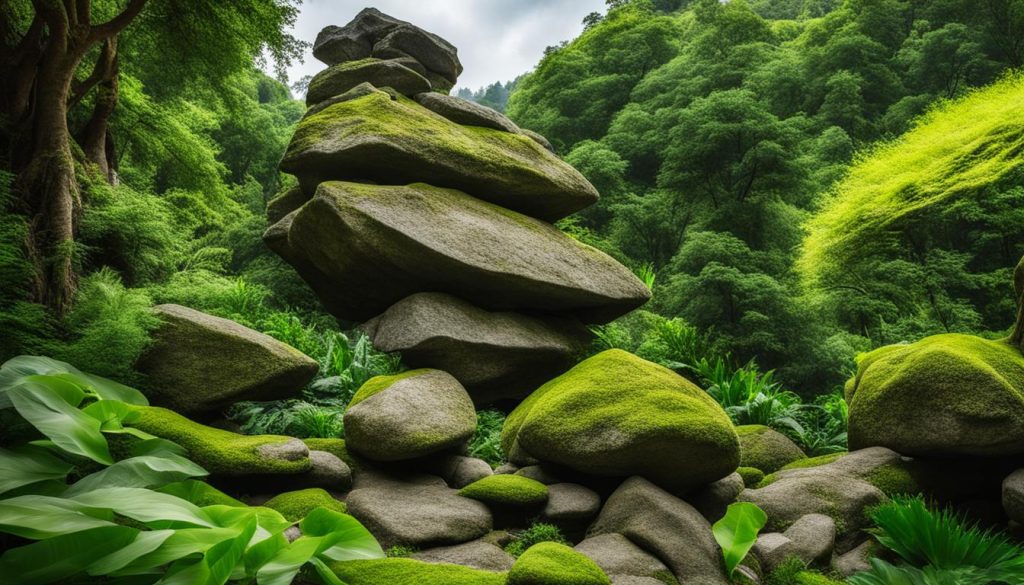
Rock Water Features
Rock water features are another creative way to incorporate rocks into your landscaping design. A water feature can include a pond, waterfall, or fountain and can be designed to fit your individual style and tastes. You can use rocks to create the structure or as decorative accents around the water feature.
| Benefits of Rock Water Features | Considerations |
|---|---|
| – Adds a tranquil and relaxing atmosphere to your outdoor space – Can drown out noise pollution – Attracts wildlife |
– Requires regular maintenance – Can be expensive to install – May require a permit depending on the type and location of the feature |
Rock Pathways
Rock pathways can add a natural and rustic charm to your outdoor space. You can use a variety of materials, such as natural stone, gravel, or pavers, to create the pathway. Depending on your preference, you can create a straight or winding pathway that leads to different areas of your garden.
Rock Garden Borders
Rock garden borders provide a unique and artistic way to separate different areas of your garden. You can use rocks to create a natural-looking edge around flower beds, walkways, and other features. This not only enhances the visual appeal of your outdoor space, but also helps keep plants and other elements contained.
- – Rock formations
- – Rock water features
- – Rock pathways
- – Rock garden borders
By incorporating these rock features into your landscaping design, you can create eye-catching elements that draw attention and enhance the natural aesthetic of your surroundings. Experiment with different combinations and arrangements to find the perfect fit for your outdoor space.
Rock Gardens: A Closer Look
Rock gardens are a beautiful and low-maintenance addition to any landscape. They offer a unique way to incorporate natural elements into your outdoor space and can be tailored to suit your personal style and taste. When designing a rock garden, there are a few key considerations to keep in mind.
Plant Selection
The right plants can make all the difference in a rock garden. Choose plants that thrive in rocky soil and can handle direct sunlight. Some popular options include:
- Sedum
- Verbena
- Lavender
- Yarrow
When selecting plants, also consider factors such as color, texture, and height. Mixing and matching different plant varieties can add depth and interest to your rock garden.
Rock Placement
The way you place rocks in your rock garden can create a sense of movement and flow. Try arranging rocks in a natural-looking pattern, rather than in straight lines. Vary the size and shape of rocks for added visual interest. Place larger rocks towards the back of the garden and smaller rocks towards the front.
Maintenance Tips
Rock gardens are generally low-maintenance, but there are a few things to keep in mind to ensure they stay healthy and beautiful:
- Keep weeds in check by hand-pulling or using a hoe.
- Water plants deeply and infrequently to promote robust root growth.
- Remove dead plant material and debris regularly to prevent disease.
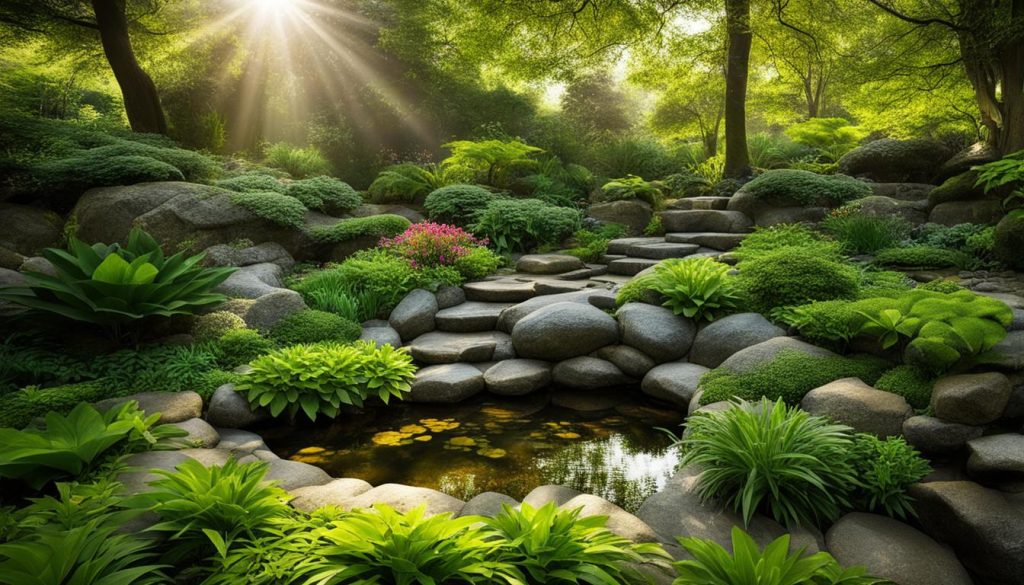
A beautiful rock garden can be a stunning focal point or accent to your landscape. With the right plant selection, rock placement, and maintenance, you can create a unique and eye-catching outdoor space.
Building Rock Pathways and Steps
Rock pathways and steps add a beautiful and functional element to any outdoor space. Here, we will explore some different techniques and materials for creating rock pathways and steps in your landscaping project.
Materials for Rock Pathways and Steps
When it comes to building rock pathways and steps, there are several materials to choose from. Natural stone slabs are a popular choice and come in a variety of colors and textures. They offer durability and a natural look that blends well with the surrounding landscape. Gravel is another option that provides a more rustic, casual feel. It’s also more affordable and easier to install than natural stone.
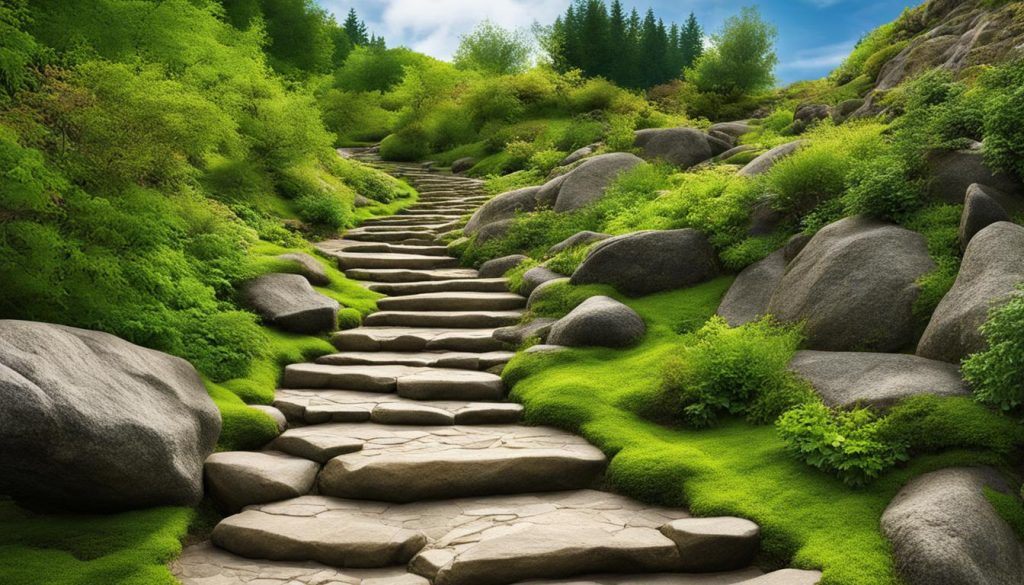
For a more modern look, concrete pavers or blocks can be used. They offer a clean, sleek appearance and are available in a range of colors and sizes. They are also durable and low maintenance, making them a practical choice for high-traffic areas.
Designing Your Rock Pathway or Steps
Designing your rock pathway or steps is an important step that can make or break the overall look of your landscaping project. Consider the size and layout of your space, as well as the natural flow of foot traffic. A curved pathway can add visual interest and a sense of movement, while steps can be used to navigate slopes or changes in elevation.
Along with choosing the type of rock and the layout of your pathway or steps, you should also consider adding lighting to enhance the safety and beauty of your design. Low-voltage LED lights can be installed along the edges of the pathway or steps, providing a soft glow and highlighting the unique textures and colors of the rocks.
Maintenance for Rock Pathways and Steps
Maintaining your rock pathways and steps is relatively easy, especially compared to other types of landscaping features. Regular sweeping and cleaning is recommended to remove debris and prevent weed growth between the rocks. In colder climates, it’s important to avoid using salt or other de-icing chemicals, as they can damage the rocks and cause them to crack or erode over time.
Conclusion
Rock pathways and steps are a beautiful and practical addition to any outdoor space. By choosing the right materials and design, you can create a stunning feature that enhances the natural beauty of your landscape. With proper maintenance, your rock pathways and steps will provide years of enjoyment and functionality for you and your family.
Rock Landscaping Tips for Canadian Climate
When it comes to rock landscaping in Canada, it’s essential to consider the climate. The harsh winter weather can pose challenges to the durability and maintenance of your rock features. Below are some tips to keep in mind when creating your rock landscaping project in Canada.
Climate Considerations
The freeze-thaw cycles that occur throughout the winter months can be damaging to rocks and stones. Water seeps into the porous surface of the rocks and expands when it freezes, causing cracks and fractures. To avoid this, it’s crucial to choose rocks that are resistant to freeze-thaw cycles and to ensure proper drainage. It’s also important to be mindful of the placement of your rocks, avoiding areas where water tends to pool or accumulate.
Winter Maintenance
Winter maintenance is critical for the longevity and visual appeal of your rock landscaping. To prevent ice buildup and damage from snow removal equipment, it’s recommended to use sand or grit instead of rock salt on your rock features. When shovelling snow, be gentle around the rocks to avoid accidental damage. It’s also important to regularly inspect your rocks and remove any debris or dead foliage that can accumulate during the winter months.
By keeping these climate considerations and winter maintenance tips in mind, you can ensure that your rock landscaping project in Canada remains beautiful and durable throughout the year. We hope these tips have been helpful and inspire you to create a stunning outdoor space that showcases the natural beauty of rock features.
If you have any questions, our team is always happy to help.
FAQ
Why should I choose rock landscaping?
Rock landscaping offers several benefits, including low maintenance requirements and exceptional durability. It can enhance the natural aesthetic of your outdoor space and add Canada’s rocky charm to your landscape.
How can I use rocks as focal points in my landscaping?
Rocks can be used as eye-catching focal points in your landscaping design. You can incorporate them in various ways, such as creating rock features or using them strategically to draw attention and enhance the overall visual appeal of your outdoor space.
What should I consider when building a rock garden?
When building a rock garden, it’s important to consider factors such as plant selection, rock placement, and maintenance. Carefully selecting plants that thrive in rocky environments, strategically placing rocks, and following proper maintenance tips will help you create a stunning rock garden that complements your surroundings.
How do I construct rock pathways and steps?
There are different techniques and materials you can use to construct rock pathways and steps. Natural stone slabs and gravel are popular choices. By incorporating these hardscaping features into your landscape, you can improve accessibility and add an attractive element to your outdoor space.
What are some tips for rock landscaping in the Canadian climate?
When undertaking rock landscaping in Canada, it’s essential to consider the climate. Factors such as freeze-thaw cycles can impact the stability of rocks. Additionally, it’s important to follow proper winter maintenance practices to ensure your rock landscaping remains beautiful and intact throughout the year.

